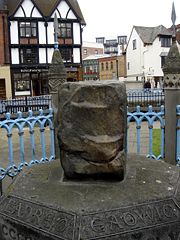
Coronation Stone
Encyclopedia
- For ScotlandScotlandScotland is a country that is part of the United Kingdom. Occupying the northern third of the island of Great Britain, it shares a border with England to the south and is bounded by the North Sea to the east, the Atlantic Ocean to the north and west, and the North Channel and Irish Sea to the...
's Coronation Stone, see Stone of SconeStone of SconeThe Stone of Scone , also known as the Stone of Destiny and often referred to in England as The Coronation Stone, is an oblong block of red sandstone, used for centuries in the coronation of the monarchs of Scotland and later the monarchs of England, Great Britain and the United Kingdom...
. For the IrishIrelandIreland is an island to the northwest of continental Europe. It is the third-largest island in Europe and the twentieth-largest island on Earth...
Coronation Stone, see Lia FáilLia FáilThe Lia Fáil , also known as the Coronation Stone of Tara, is a stone at the Inauguration Mound on the Hill of Tara in County Meath in Ireland, which served as the coronation stone for the High Kings of Ireland. In legend, all of the kings of Ireland were crowned on the stone up to Muirchertach...
. For the SwedishSwedenSweden , officially the Kingdom of Sweden , is a Nordic country on the Scandinavian Peninsula in Northern Europe. Sweden borders with Norway and Finland and is connected to Denmark by a bridge-tunnel across the Öresund....
Coronation Stones, see Stones of MoraStones of MoraStones of Mora was the place where the Swedish kings were elected. The origin of the tradition is unknown.-Mora Meadow:In Lagga parish about 10 km south-east of Uppsala, but in neighbouring Knivsta Municipality, is Mora äng...
.

Guildhall
A guildhall, or guild hall, is a building historically used by guilds for meetings and other purposes. It is also the official or colloquial name for many of these specific buildings, now often used as town halls or museums....
in Kingston upon Thames, England
England
England is a country that is part of the United Kingdom. It shares land borders with Scotland to the north and Wales to the west; the Irish Sea is to the north west, the Celtic Sea to the south west, with the North Sea to the east and the English Channel to the south separating it from continental...
. Kingston
Kingston upon Thames
Kingston upon Thames is the principal settlement of the Royal Borough of Kingston upon Thames in southwest London. It was the ancient market town where Saxon kings were crowned and is now a suburb situated south west of Charing Cross. It is one of the major metropolitan centres identified in the...
is now a suburb
Suburb
The word suburb mostly refers to a residential area, either existing as part of a city or as a separate residential community within commuting distance of a city . Some suburbs have a degree of administrative autonomy, and most have lower population density than inner city neighborhoods...
of London
London
London is the capital city of :England and the :United Kingdom, the largest metropolitan area in the United Kingdom, and the largest urban zone in the European Union by most measures. Located on the River Thames, London has been a major settlement for two millennia, its history going back to its...
and was once the county town
County town
A county town is a county's administrative centre in the United Kingdom or Ireland. County towns are usually the location of administrative or judicial functions, or established over time as the de facto main town of a county. The concept of a county town eventually became detached from its...
of Surrey
Surrey
Surrey is a county in the South East of England and is one of the Home Counties. The county borders Greater London, Kent, East Sussex, West Sussex, Hampshire and Berkshire. The historic county town is Guildford. Surrey County Council sits at Kingston upon Thames, although this has been part of...
.
In Old English, tun, ton or don meant farmstead or settlement, so the name Kingston appears to mean farmstead of the kings. Early sources claim that at least seven of the old Saxon kings of England were crowned at Kingston as they stood or sat on the stone. A local legend that these Saxon coronations gave Kingston its name is contradicted by the records of the 838 council.
The names of the seven kings are now inscribed around the Stone's plinth
Plinth
In architecture, a plinth is the base or platform upon which a column, pedestal, statue, monument or structure rests. Gottfried Semper's The Four Elements of Architecture posited that the plinth, the hearth, the roof, and the wall make up all of architectural theory. The plinth usually rests...
. These were:
- Edward the ElderEdward the ElderEdward the Elder was an English king. He became king in 899 upon the death of his father, Alfred the Great. His court was at Winchester, previously the capital of Wessex...
- AthelstanAthelstan of EnglandAthelstan , called the Glorious, was the King of England from 924 or 925 to 939. He was the son of King Edward the Elder, grandson of Alfred the Great and nephew of Æthelflæd of Mercia...
- Edmund I of EnglandEdmund I of EnglandEdmund I , called the Elder, the Deed-doer, the Just, or the Magnificent, was King of England from 939 until his death. He was a son of Edward the Elder and half-brother of Athelstan. Athelstan died on 27 October 939, and Edmund succeeded him as king.-Military threats:Shortly after his...
- Eadred of England
- Eadwig of England
- Edward the MartyrEdward the MartyrEdward the Martyr was king of the English from 975 until he was murdered in 978. Edward was the eldest son of King Edgar, but not his father's acknowledged heir...
- Æthelred the Unready

